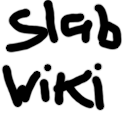More actions
This is the style guide for SlabWiki.
Article Titles, Sections, Headings
Article Titles
A title should be a recognizable name or description of the topic.
- Follow title case for capitalization.
- Do not use articles (a, an, or the) as the first word. For example Economy of the Second Empire, not The economy of the Second Empire, unless it is an inseparable part of a name (The Hague) or of the title of a work (A Clockwork Orange, The Simpsons).
- Normally use nouns or noun phrases: Early Life, not In Early Life.
- The final character should not be punctuation unless it is an inseparable part of a name (Saint-Louis-du-Ha! Ha!, 'Do Androids Dream of Electric Sheep?') or an abbreviation (Inverness City F.C.), or when a closing round bracket or quotation mark is required ('John Palmer' (1814 schooner)).
Section Organization
An article's content should begin with an introductory lead section – a concise summary of the article – which is never divided into sections.
Infoboxes, images, and related content in the lead section must be right-aligned.
Certain standardized templates that are not sections go at the very top of the article, before the content of the lead section, and in the following order:
- A short description, with the
{{Short description}} - An infobox, which is optional; usually also includes the first image.
- Ideally an introductory image, when an infobox is not used, or an additional image is desired for the lead section.
If the topic of a section is covered in more detail in a dedicated article, insert {{main|Article name}} immediately under the section heading.
Section Headings
Section headings should generally follow the guidance for article titles.
When editing in source mode, the heading must be on its own line, with one blank line just before it; a blank line after (but do not use two blank lines, before or after, because that will add unwanted visible space).
For technical reasons, section headers should:
- Be unique within a page, so that section links lead to the right place.
- Not contain links
- Not contain images or icons
- Not contain HTML markup e.g.
<math> - Not contain citations or footnotes
These technical restrictions are necessary to avoid technical complications and are not subject to override by local consensus.
As a matter of consistent style, section headings should:
- Not redundantly refer back to the subject of the article, e.g., Early life, not Smith's early life or His early life
- Not refer to a higher-level heading, unless doing so is shorter or clearer
- Not be numbered or lettered as an outline
- Not be phrased as a question, e.g., Languages, not What languages are spoken in Mexico?
- Not use color or unusual fonts that might cause accessibility problems.
- Not be wrapped in markup, which may break their display and cause other accessibility issues.
Before changing a heading, consider whether you might be breaking existing links to it.
Capital Letters
SlabWiki article and section heading use title case, not sentence case; see SlabWiki:Article Titles and § Section Headers. For capitalization of list items, see § Bulleted and Numbered Lists. Other points concerning capitalization are summarized below.
Calendar Items
- Months, days of the week, and holidays start with a capital letter (June, Monday).
- Seasons are in lowercase (her last summer; the winter solstice; spring fever), except in personifications or in proper names for periods or events
